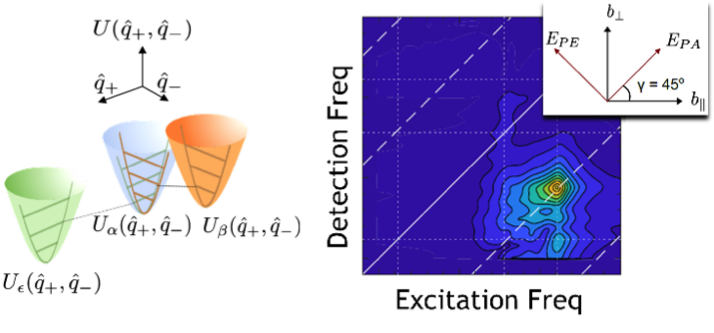Beats that matter: Deciphering the coupled motions of electrons and nuclei that drive singlet fission

(Left) In-phase (q+) and anti-phase (q-) bond motions together couple different pairs of electronic states. (Right) Such couplings can be probed by using polarisation-controlled femtosecond pulses and correlating excitation and detection frequency locations of the resulting quantum beats.
Singlet Fission – the fission of an electronically excited singlet state into two free triplets – was first reported in the 1960s. This phenomenon has garnered tremendous recent interest given the promise of disruptive next-generation solar cell technologies using synthetically tailorable molecules that can, in principle, harvest the entire solar bandwidth into two charge carriers with one initial photoexcitation. The first step of this fission process can occur in as fast as 100 femtoseconds (10-15 secs) with near unity quantum efficiency in certain archetypal molecular thin films. What’s remained elusive so far is what exactly causes the electronic states to convert so rapidly given that they are not directly coupled, with even the mediated couplings being too weak to explain this rate and efficiency.
The Born-Oppenheimer approximation, that is, the assumption of no couplings between fast electrons and slow nuclear motions, is central to chemistry and helps us visualise bond vibrations as nuclear motions on an adiabatic potential energy surface created by the electrons. Breakdown of this approximation, however, can drive one of most efficient electronic energy funnels through directed nuclear motions of a fraction of a bond length. Such non-adiabatic effects are well established in initiating photoexcited phenomena such as mammalian vision, photosynthesis and quantum phase transitions.
Now, reporting in the Proceedings of the National Academy of Sciences (USA), Bhattacharyya, Sahu, Patra and Tiwari at the Solid State and Structural Chemistry Unit (SSCU) show that fast large amplitude nuclear motions and slow intermolecular nuclear motions that modulate orbital overlaps together create a robust non-adiabatic electronic funnel for singlet fission. “Our study adds crucial ingredients in molecular design that had so far ignored the role of nuclear motions,” explains corresponding author Vivek Tiwari, Assistant Professor at SSCU. Using time-resolved spectroscopy to decipher such nuclear motions that drive non-adiabatic chemistry is of vital mechanistic significance. The authors show that quantum beats created by polarisation selective femtosecond photoexcitation can in fact probe such non-adiabatic couplings to unambiguously identify the promoter vibrations in singlet fission. “Such experiments can help synthetic chemists come up with better design strategies for singlet fission materials,” says Atandrita Bhattacharyya, first author and PhD student at SSCU.
REFERENCE:
Bhattacharyya A, Sahu A, Patra S, Tiwari V, Low- and high-frequency vibrations synergistically enhance singlet exciton fission through robust vibronic resonances, Proceedings of the National Academy of Sciences (2023).
https://www.pnas.org/doi/10.1073/pnas.2310124120
WEBSITE:
https://sites.google.com/view/musig/



